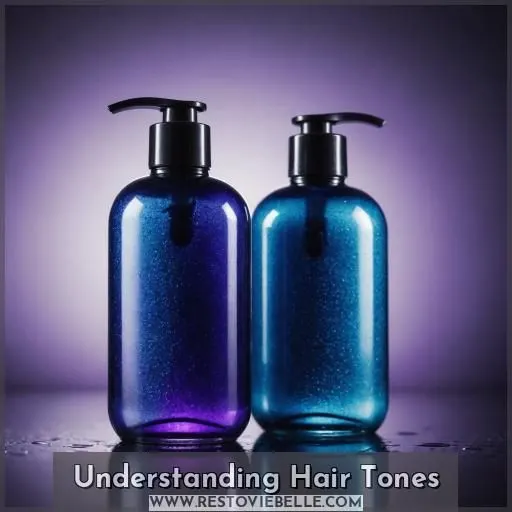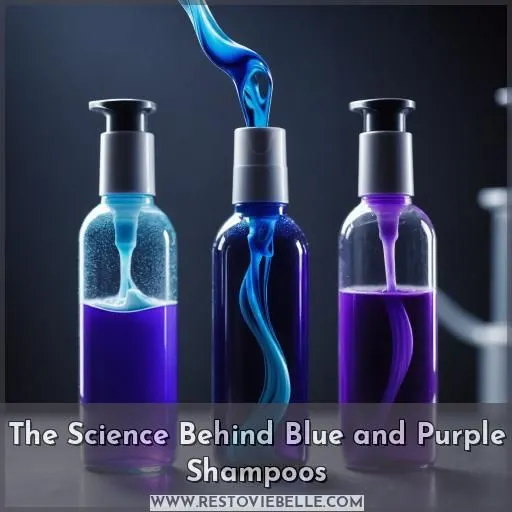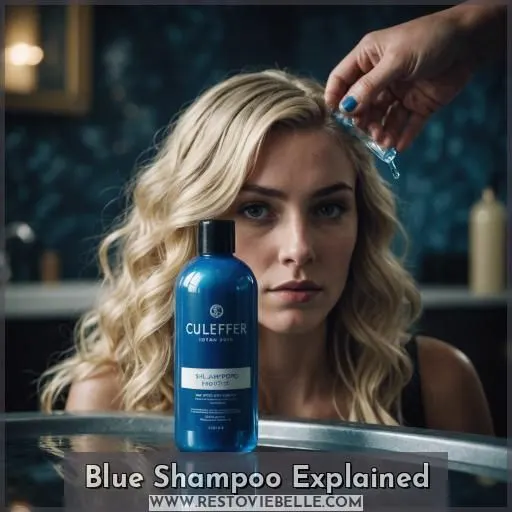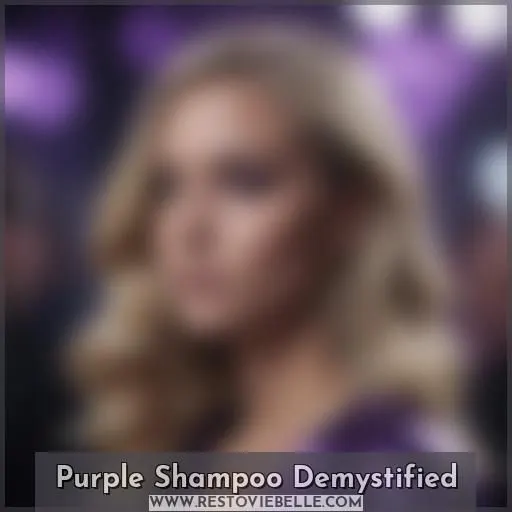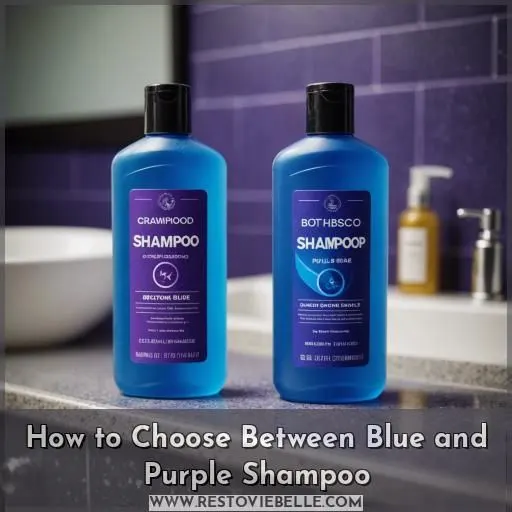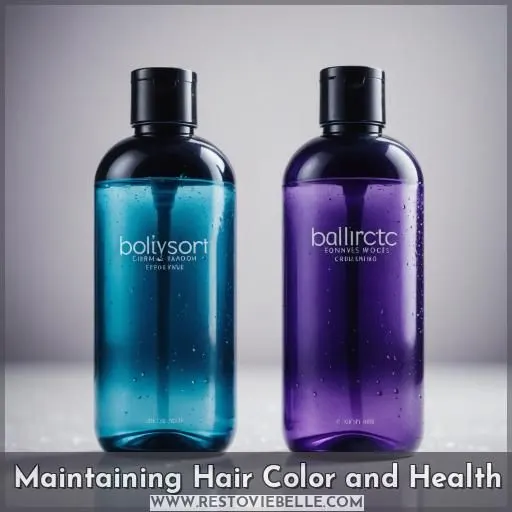This site is supported by our readers. We may earn a commission, at no cost to you, if you purchase through links.
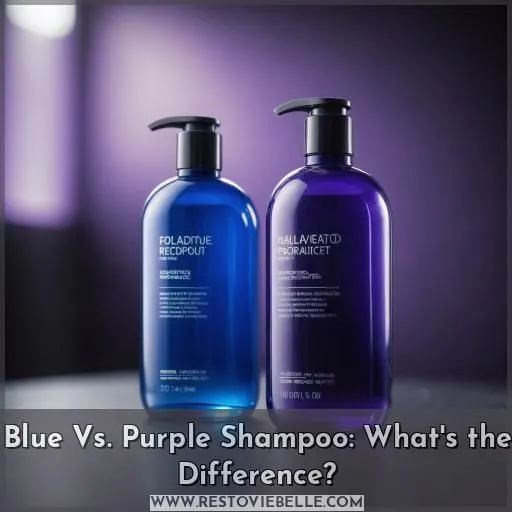 When weighing the choice between blue shampoo and purple shampoo, it’s crucial to contemplate your hair’s undertones. Blue shampoo neutralizes orange hues in brunette hair, safeguarding its richness and glow. Conversely, purple shampoo combats yellow undertones, giving blonde or gray hair a cool, ashy appearance.
When weighing the choice between blue shampoo and purple shampoo, it’s crucial to contemplate your hair’s undertones. Blue shampoo neutralizes orange hues in brunette hair, safeguarding its richness and glow. Conversely, purple shampoo combats yellow undertones, giving blonde or gray hair a cool, ashy appearance.
Your selection should harmonize with your hair color and desired result. Blue shampoo is optimal for darker hair, while purple shampoo complements lighter shades.
By comprehending the science behind these color-correcting shampoos, you can maintain vibrant, healthy-looking hair. For customized application advice and insights on how to preserve the vibrancy of your color, further research will yield valuable knowledge.
Table Of Contents
Key Takeaways
- Blue shampoo neutralizes orange tones in brunette hair, while purple shampoo combats yellow undertones in blonde or gray hair.
- The choice between blue and purple shampoo depends on your hair color and desired result.
- Blue shampoo is best for darker hair, while purple shampoo complements lighter shades.
- Both shampoos can be used to maintain hair color and keep brassy tones at bay.
Understanding Hair Tones
Hair color is more than just a shade; it’s a complex interplay of pigments and undertones that can influence the overall appearance of your locks. Brunettes, for example, often have warm undertones of orange or red, while blondes typically exhibit yellow undertones. When these warm tones start to appear in your hair, it’s referred to as brassiness. To combat this, you can use blue or purple shampoo, which work by neutralizing unwanted tones and extending the lifespan of your color treatment.
Blue shampoo is designed to counteract orange tones in brunette hair, while purple shampoo is used to banish brass in blonde hair. The color wheel is the key to understanding which shampoo to use. Blue sits opposite orange on the color wheel, so blue shampoo effectively neutralizes orange tones. Similarly, purple sits opposite yellow on the color wheel, making purple shampoo ideal for neutralizing yellow undertones.
When choosing between blue and purple shampoo, consider the tone you want to remove. Brunettes may lose their shine to brassy orange tones, while blondes may fade into an unnatural yellow color. Both shampoos can be used to maintain hair color, but the choice depends on the specific undertones you’re trying to correct.
The Science Behind Blue and Purple Shampoos
The science behind blue and purple shampoos lies in color theory, a concept that uses color to create contrast and balance. These shampoos work by depositing pigments into the hair to neutralize unwanted tones. Here’s how they work:
- Color Theory: Blue and purple shampoos use color theory to counteract brassy tones. Blue shampoo neutralizes orange tones, while purple shampoo neutralizes yellow tones.
- Chemical Reaction: When applied to the hair, these shampoos undergo a chemical reaction with the hair’s porosity, allowing the pigments to deposit and neutralize discoloration.
- Pigment Deposition: Blue shampoo contains blue pigments that neutralize orange tones, while purple shampoo contains violet micro-pigments that neutralize yellow tones.
- Hair Porosity: The hair’s porosity affects how well the shampoo works. Highly porous hair may require more frequent applications, while less porous hair may need less frequent use.
- Damage Prevention: Blue and purple shampoos can also help prevent damage by acting as a hair toner, sealing the cuticle and protecting the hair from environmental stressors.
When choosing between blue and purple shampoo, consider the tone you want to neutralize. Blue shampoo is best for orange or brassy tones, while purple shampoo is ideal for yellow tones. Both shampoos can be used to maintain hair color and keep brassy tones at bay.
Blue Shampoo Explained
Let’s explore the realm of blue shampoo, your hidden treasure for eradicating brassiness in brunette hair. Unlike its purple counterpart, blue shampoo employs blue pigments to neutralize orange tones. It acts as a chromatic enchantment, counteracting unwanted hues and unveiling your hair’s inherent brilliance.
Brunettes, celebrate! Blue shampoo is your savior for preserving your hair’s depth and complexity. Whether you flaunt a rich chocolate brown or a sun-kissed balayage, blue shampoo will ensure your color remains vibrant and alluring. It’s like a revitalizing elixir, restoring your hair’s natural radiance and vanquishing any brassy foes.
Purple Shampoo Demystified
Purple shampoo is a lifesaver for blondes and those with gray hair. It contains violet pigments that neutralize unwanted yellow tones, giving you a cool, ashy look. It’s like a magic wand for banishing brassiness and keeping your hair looking fresh and vibrant.
- Corrects Brassy Tones: Purple shampoo is the secret weapon against brassy yellow tones that can creep into blonde or gray hair.
- Enhances Highlights: It accentuates highlights, making them pop and adding depth and dimension to your hair.
- Maintains Color Vibrancy: Regular use of purple shampoo helps maintain the vibrancy of your hair color, preventing it from fading or becoming dull.
- Versatile for Different Hair Types: Whether you have natural blonde hair, highlights, or gray hair, purple shampoo can work its magic, giving you a cool, sophisticated look.
How to Choose Between Blue and Purple Shampoo
Now that you’re familiar with the color-correcting capabilities of blue and purple shampoos, it’s time to decide which one is right for your hair. Here’s a simple breakdown:
- Yellow undertones? Go purple. Purple shampoo neutralizes those unwanted brassy tones, leaving you with cool, icy blonde or silver locks.
- Orange undertones? Opt for blue. Blue shampoo cancels out orangey hues, keeping your brunette hair vibrant and multi-dimensional.
- Multiple undertones? Combine forces. If your hair has both yellow and orange undertones, you can use both shampoos to achieve the desired result.
- Dark hair vs. light hair? Blue shampoo is generally better for darker hair, while purple shampoo is more suitable for lighter hair. This is because blue pigments tend to be more effective on darker tones, while purple pigments work better on lighter tones.
Application Tips for Maximum Effect
Regarding the use of blue and purple shampoos, follow these crucial tips for optimal outcomes:
- Color mixing: Grasp the color wheel and the shampoos’ functions. Blue shampoo neutralizes orange hues, while purple shampoo neutralizes yellow tones. This is critical for selecting the right shampoo for your hair type and desired color result.
- Pigment intensity: Be aware of the pigments’ strength. Excessive use of these shampoos can result in an unnatural appearance. It’s advisable to alternate with your regular shampoo and use them infrequently to achieve the best results.
- Root effects: Focus on the roots of your hair. Blue shampoo is more effective for neutralizing orange tones in brunette hair, while purple shampoo is better for counteracting yellow tones in blonde hair.
- Duration of application: Adhere to the manufacturer’s guidelines for the duration of application. Typically, you should leave the shampoo on for 2-4 minutes before rinsing with cool water.
- Scalp sensitivity: Be mindful of any scalp sensitivity. Some people may find that blue or purple shampoos cause irritation or dryness, so it’s imperative to test a small amount on your scalp before using the product on your entire head.
- Hair care and maintenance: Integrate these shampoos into a comprehensive hair care routine. This includes using a conditioner specifically designed to complement the shampoo, and applying a heat-protectant spray during styling to preserve the color.
Maintaining Hair Color and Health
Maintaining hair color and health is essential for achieving optimal results from your blue or purple shampoo. To guarantee your hair remains radiant and healthy, consider adopting a hair care routine that emphasizes:
Hair hydration
Hair breakage reduction
Utilize split end treatments to preserve the appearance of your ends, and prevent scalp irritation by selecting a shampoo tailored to your hair type. For those with color-treated hair, choose a hair color enhancement shampoo to revitalize your color and extend its life between salon appointments.
Frequently Asked Questions (FAQs)
How often should I use blue or purple shampoo?
To maintain the vibrancy and color of your hair, you should use blue or purple shampoo once or twice a week, depending on your hair type and color. Overuse can lead to a slight purple hue, especially for those with light or damaged hair. If this happens, try using the shampoo a few times a week instead of daily. Always follow the instructions on the shampoo label for the recommended duration of use and consider your hair texture and condition.
Can I use both blue and purple shampoo together?
Yes, you can use both blue and purple shampoo together. To maintain your hair color and keep brassy tones at bay, you can alternate between the two shampoos. If you see more orange tones, use purple shampoo once for every two or three times you use the blue. Vice versa for more prominent yellow tones.
Allow the shampoo to sit in your hair for 2-3 minutes after sudsing up, and follow with a blue or purple conditioner.
Both shampoos work by coating the hair shaft, canceling out brassiness, and adding shine.
Is it safe to use blue or purple shampoo on damaged hair?
Yes, it’s safe to use blue or purple shampoo on damaged hair. Both blue and purple shampoos are designed to neutralize brassy tones and add shine to hair, making them suitable for damaged hair as well. However, it’s recommended to use them in moderation and to avoid over-use by mixing with regular shampoo.
Can I use blue or purple shampoo on curly hair?
Yes, you can use blue or purple shampoo on curly hair. Blue shampoo is designed to neutralize orange tones, which can be beneficial for brunettes with curly hair who may have warm undertones.
Purple shampoo, on the other hand, is used to banish brass in blonde hair, which can be helpful for those with lighter hair colors and curls.
Both shampoos can be used to maintain the color and vibrancy of curly hair, but it’s key to choose the right one based on your hair color and the undertones you want to counteract.
Are there any natural alternatives to blue or purple shampoo?
Yes, there are natural alternatives to blue and purple shampoo. You can make your own purple shampoo at home using apple cider vinegar, which can help counteract brassiness and deliver a deep cleanse.
For a more natural store-bought option, you can consider using a conditioner like the one from Lauren Marie Hair, which is purple in color but doesn’t turn hair purple when left in for a while.
Additionally, you can try using a blue toning conditioner from Overtone, which is also a natural alternative to traditional blue shampoo.
Conclusion
Have you ever wondered which shampoo is best for your hair color? Understanding the science behind these color-correcting shampoos can help you make the right choice. Blue shampoo neutralizes orange hues in brunette hair, while purple shampoo combats yellow undertones in blonde or gray hair.
By choosing the right shampoo, you can maintain vibrant, healthy-looking hair. With the right application tips and maintenance techniques, you can keep your color looking its best.
